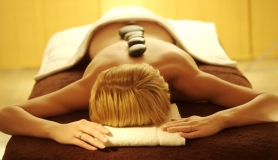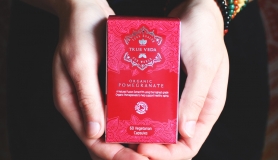‘It took us a long journey of 13 years before we finally welcomed our first baby into our family. To help us conceive we used an astrological conception plan, vedic fire rituals to eliminate negative karma, mantra chanting and hours of meditation. We experienced so many emotional ups and downs in those years. We worked to increase fertility with the help of Ayurveda, changing habits and, most importantly, making a shift in our mindset. We realised that we were set on the idea of having children for the sake our egos. Using techniques we became a soul duo, offering our love, time and knowledge to help the souls of our children come into this world, to help them deal with their karma, transform their consciousness and fulfill their purpose in life. We moved from focusing on our own desires to wanting to meet our future childrens’ needs.
During this time we moved to Marupe, a small town in the Riga suburbs. My parents and brothers live here too. Planning a home birth we wanted more quiet, green spaces and a healthier environment with plenty of fresh air and a nearby pond to take peaceful walks together. We wanted our living environment to be really special.
GENERATION GAME
It is very important for us as a Vedic family to have multiple generations living as close to one another as possible. There are so many benefits to being within walking distance of each other: we share babysitting, grocery shopping, travel into the city etc. In the Vedic tradition, the elder generation feels useful, they don’t experience empty nest syndrome and they are looked after by the middle and younger generation. The middle generation have the support from the experience and maturity of elders. But the most powerful aspect is the sense of family; rootedness, protection and shared wisdom. Nowadays most families live so far away from one another that the communication between generations is often limited. Teachers and nannies can teach different skills, but they cannot teach the sense of belonging to family. In our global culture it’s easy to get lost and to feel ungrounded, that’s why close multi-generational interaction is so important. Having family support as young parents is invaluable, especially in the first month. My mum spent days and sometimes even nights with us after both our babies were born.
THE JOURNEY BEGINS
When my husband and I first got married I had mastopathy (multiple pea and bean sized lumps in my breasts) and vegetative dystonia, which made me anxious every time I traveled by public transport. I was taking several different pills, including a tranquilizer, that made me feel “stoned” for most of the day. One day when anxiety struck once again, I realised that I wanted to change my life from the very core. And it was obvious that the core was within myself rather than the doctor’s office.
I didn’t intentionally look for alternative medicine, yoga or any other solutions. But when a yoga class started nearby and both my brothers expressed an interest in learning, I went along and my vedic journey began.
My husband was skeptical about my new passion. He thought I had joined some sort of sect. But he couldn’t help but notice the impact that yoga had on my physical and emotional health, and so he joined me at a lecture about love and vedic relationships. He took up vedic studies straight away. He worked a “normal” job in the daytime and studied Vedas in the evening. The next step was when we became vedic astrologers, yoga teachers, scholars of vedic sciences and started working at our guru’s yoga centre in Riga.
Vedic knowledge impacts every little thing we do in our family. The Vedas are like a user’s manual for living in tune with the laws of nature. Yoga is not something that we do only several hours per week. It is our lifestyle, we practice 24/7. Compared to 20 years ago, the vedic lifestyle has influenced not only my daily routine, health and eating habits, but also changed the way I walk, talk, breathe, sleep, think and make decisions.
PHYSICAL PRACTICE
My children started doing yoga during each of my pregnancys! Yoga practice helped me prepare for childbirth. It brought an awareness of my relationship with my child. The unity helped to feel the child’s signals during labour and later on it enabled us to develop a relationship that literally works like telepathy.
Children copy their parents in everything they do. Our children take part in daily mantra chanting if they want to. We don’t push them, but they usually come, join us and sit with their chanting beads, murmuring mantras. Our morning hatha yoga practice at home doesn’t look anything like you’d see in class. The reality is that whatever asana (posture) I manage to fold my body into, I automatically become someone else’s slide, horse, house or nest. I hardly ever manage a continuous flow of postures. I just accept it and this helps me not to get annoyed by their involvement in my practice. What seems like just crawling and playing around, is in fact learning asanas. Later on they are able to mirror those postures much easier. Now that Paul is five, his practice really looks much like mine.
NON VIOLENT DIET
The way that we eat is Ayurvedic lacto-vegetarian. We don’t eat meat, chicken, fish, seafood and eggs, but we use milk products and honey from non-industrial origin. That is important because vedic lifestyle is about non-violence and treating animals as family members. Ayurvedic cooking does not belong to any specific country or region due to the fact that any food can be cooked following the principles of Ayurveda. It means you have to balance all six flavours and take into account the marriage of ingredients. One can cook, for instance, a pizza or pilaf and apply the principles of Ayurvedic cooking. It’s a way of preparing food. The result is a meal that is not only satisfying for the taste-buds, but also medicine for the whole body.
The Vedic lifestyle focusses on the purification, development and transformation of people’s consciousness, which is accompanied by great changes in life quality. Everything goes hand in hand, and therefore this aim cannot be achieved without sattvic (harmonious) food, which is rich in life-force or prana. One can’t have peace and harmony in body, mind and life, if eating inappropriate food. Paul and Darta eat pretty much everything. They have “taste intelligence”, which develops gradually, starting in pregnancy. I ate satisfying homemade meals whilst they were in utero, small portions, more frequently. I breastfed them (and still am breastfeeding Darta), and they got used to different tastes through my milk. By six months when they could sit by themselves without support, I did what mothers have done for many generations before the blender was invented. I offered pieces of steamed vegetables, which are easy to hold in little hands, and let them taste food at their own pace. Nowadays this ancient method is called baby-led weaning. Everybody knows that children learn best through play, so my kids played and ate simultaneously without interference or enforcement. Paul no longer sinks his hand into porridge, but Darta is experimenting with/eating whatever is on her plate. They learn to chew, not just swallow food, which is essential for nurturing a healthy digestive system. Children fed this way learn to take charge of their needs and are not just passive consumers of food in the quantity that the person feeding them decides. They tend not to overeat and learn to listen to their own body signals and respond to them. And they learn table manners early.
“Children fed this way learn to take charge of their needs and are not just passive consumers of food in the quantity that the person feeding them decides”
So what is our daily menu? The nutritional needs of each member of my family is different; we all have our own constitution. It is actually quite easy to satisfy everybody’s needs. We cook Ayurvedic meals that have the ability to balance all three doshas (see notes). We make different kinds of kitcharis (lentils and rice with seasonal vegetables and Ayurvedic spices cooked in ghee), soups with vegetables, legumes and sometimes grains (like oats or barley) and fresh green salads (mostly in the warm season) combined with cold pressed oils and lemon juice. I have such a sweet tooth, but I stopped eating processed sugar and now make desserts, cakes and sweets at home using dates, figs, honey and raw sugarcane juice as natural sweeteners.
CREATING HARMONY
My husband and I have been together for 18 years. We have had our ups and downs in our relationship but yoga has kept our relationship strong for such a long time. It has taught me not to blame my husband for things, because dissatisfaction with another person comes from dissatisfaction with oneself. The Vedic lifestyle has taught me to love myself first and from that place I am able to give love to my spouse, children and the rest of the world. This is called viveka in the Vedas. It is an ability to see the difference between cause and effect. I always look for cause within, not outside.
The Vedic lifestyle helped me to connect with my inner primal mothering instinct and gather power and confidence in my own strength when my children were born. I had plenty of fears and doubts before labour. Especially with my first child. Meditation helped me clear the doubts about whether I had the strength and what might go wrong. This experience helped me grow as a woman, making me a better mother and a better person on the whole.
Atis and I share the same values and we raise our children within the frame of our values. Simultaneously though we respect our kids’ rights to form their own values. The Vedas state non-violence towards oneself and others, and that is what makes our family work.
HEALTHY LIVING
We use Ayurveda for healing and prevention of diseases, for rejuvenation and beauty care. It means that we look after our immune systems so that we rarely fall ill. If we do, we boost the immune system with natural Ayurvedic remedies.
We live in close relation to seasonal rhythm. Cold season in Latvia is from October until April. We keep warm by observing several Ayurvedic recommendations, such as drinking warm drinks and never refrigerated beverages. Ayurvedic tea helps the digestive fire. It is important to maintain that flame as it keeps the immune system functioning.
When it comes to food: we eat seasonal vegetables harvested from our family garden. Mostly we eat cooked food, much less raw during the cold season. We supplement homegrown produce with extra from local farmers’ markets. We eat a lot of lentils and mung beans, nuts and seeds (almonds, walnuts, flax, sesame, mustard seeds etc.), because they have a warming effect on body. We reduce “cooling” products like milk and milk products, spicy foods, coconut etc.
We also oil our bodies inside and out. We use mostly sesame oil externally, because it is a classic Ayurvedic warming oil for this purpose. I drink a tablespoon of warm ghee mixed with little bit of dry ginger in the morning on an empty stomach. This helps to cleanse the toxins in every single cell and helps to calm down vata dosha, that usually becomes the dominant dosha in the cold season.
We perform different rituals for the spring and autumnal equinox as well as on winter and summer solstices. During those festivals we gather together with our disciples and perform vedic fire rituals (homas) or mantra rituals (poojas) to honor different vedic deities. It helps to invoke specific energies in our consciousness and life. Moreover, it helps us to tune in with nature’s rhythm. Kids love to engage in preparation for festivals, decorating the house and cooking special festive meals. Its quite educational for them to follow and learn the flow of time, seasons and calendar in general.
MORE INSPIRATION
READ More at vediclifestyle.guru
FOLLOW Linda on Facebook @lindazarinayoga and Atis on Facebook @AtisZarinsvedas
TRY THIS AT HOME
6 vedic practices for you and your family
- Try waking up before sunrise or before. Have a warm bath or shower and have a cup of warming Ayurvedic tea.
- See everything in your life as being the reflection of your own consciousness. Your consciousness is the manifestation of god, meaning that everything in your life, including you, is of divine origin. Practicing this you might be able to avoid unnecessary quarrels, blaming others, self-pity etc.
- Cook and eat only if you are in a good mood. The same principle applies to making love. Eating and having sex are both circumstances when the subtle body opens up and takes in every single vibration. Let them be positive and loving vibes.
- Try burning natural incense sticks at home. They will not just smell good but also cleanse the living space from negative vibrations, like those after quarrels, crowded parties, bad news and gossip. They might even be helpful to relieve headache.
- Look at your children as souls of ancestors, who need your help navigating this modern world. For every “don’t do that”, try to find a way to say “do this instead”.
- Look for a vedic lifestyle teacher, who is practicing what he/she preaches. The genuine vedic knowledge is traditionally handed over orally from teacher to disciple. This is how the linage of teachers of the past pass over their knowledge and this is the way how the vedic knowledge is kept alive. There are nuances and even secrets that are not written and never will be written in books. Books can teach basic things, but a teacher can tailor the knowledge in a way that you understand it better. Even the best tennis players in the world have coaches.
NOTES ON DOSHAS
There are three body constitutions - vata, pitta and kapha - that form our body in a unique proportion for each and every individual. The goal of Ayurveda is to have all of them in balance in order to have a sound health. Each dosha is a pair of elements. Vata consists of Air and Wind, Pitta is made of Fire and Water, but Kapha - Water and Earth.







